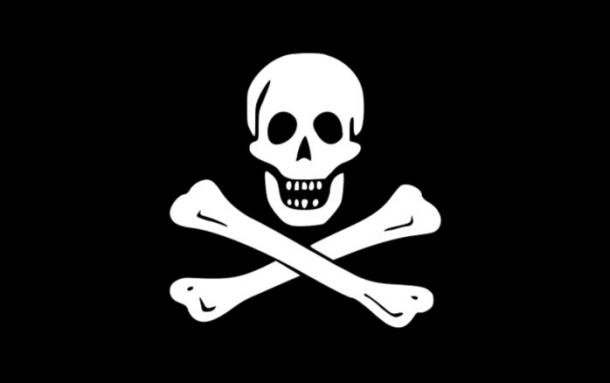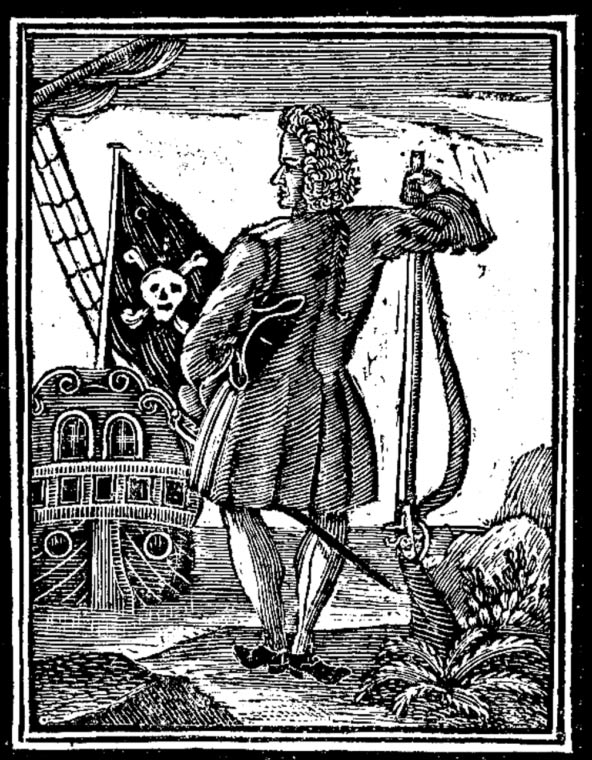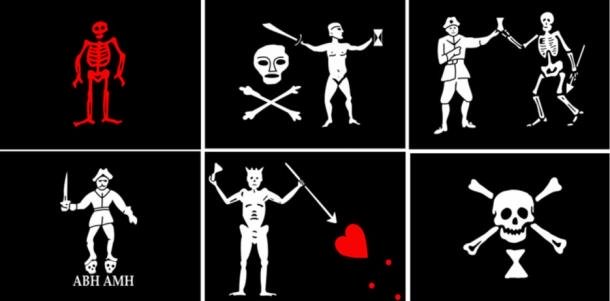Pirate lore is a popular topic among many today, with romanticized tales involving adventure on the high seas, camaraderie, and treasure hunting. However, centuries ago, pirates were very real criminals, one of the first examples of organized crime. Traveling by sea, pirates would attack and plunder, killing with disregard.
There are many objects of piracy that are used as symbols of the practice today – walking the plank, a wooden leg, an eye patch , a hook for a hand, and a single gold hoop earring. However, the most commonly recognized symbol of piracy throughout the years has been the black flag with the skull and crossbones design – the Jolly Roger. As a symbol, the Jolly Roger was flown on pirate ships to convey a message to their targets. It was meant to instill fear and to demonstrate that those onboard were extremely powerful .

The traditional “Jolly Roger” flag of piracy. ( CC BY SA 3.0 )
The Significance of Pirate Flags
The use of pirate flags in general mimics the use of flags on other ships. Throughout maritime history a ship would display a particular flag to convey a message, mainly to indicate where a ship’s allegiance laid. For example, private ships would fly a different flag than naval ships.
To the same extent, pirate ships would fly certain flags to communicate a message, or even to trick nearby ships into believing the pirate ship was an ally and give the pirate ship an advantage in subsequent attacks.
Historically, a pirate ship which was attacking would fly a solid black flag. This would indicate that, so long as no one resisted the attack of the pirates, all would be given quarter. However, upon resistance the flag would be changed to a solid red flag indicating that no mercy would be shown.
The purpose of the flag was to instill fear in those being attacked, giving the pirates even more power. The solid red or black flag was originally referred to as the Jolly Roger, before the name came to be associated with the skull and crossbones.

1725 woodcut of Stede Bonnet with a Jolly Roger. (Public Domain)
Why is it Called the Jolly Roger?
It is debated why the pirate flag is called the Jolly Roger, with uncertainty as to where the phrase came from. In 1724, Charles Johnson published a book called “A General History of the Pyrates.” This is where the phrase “Jolly Roger” is said to have originated, as Johnson cites not one, but two pirates who called their flag the Jolly Roger: Bartholomew Roberts in June of 1721 and Francis Spriggs in July of 1723.
Still others believe that the words Jolly Roger were derived from the French “ jolie rouge ,” meaning “pretty red.”
In the book “Pirates & the Lost Templar Fleet” David Hatcher Childress provides another possible origin for the phrase Jolly Roger. In this book, Childress indicated that the Jolly Roger was actually named after King Roger II of Sicily, a Templar who was believed to be the first man to fly the flag.

A torn Jolly Roger. ( adimas /Adobe Stock)
The Many Variations of the Jolly Roger
Today, the Jolly Roger – a black flag with a skull and crossbones on it – is considered to be the standard design for a pirate flag. However, this was not the original design for the Jolly Roger, which has taken many different arrangements over the years.
In Charles Johnson’s “A General History of the Pyrates,” two pirates flew a flag they called the Jolly Roger, but neither of those Jolly Rogers featured the design of a skull and crossbones. From this we can ascertain that the Jolly Roger was not intended as a depiction of a particular design so much as a generic term used to describe any pirate flag.
The variations on the pirate flag over the years have been many, ranging from solid black or red, to varying black and red designs, including images of skeletons, weapons, blood, and hearts. Some examples of the Jolly Roger over time include:

Different flag designs used by pirates over the centuries. (Public Domain)
Why a Skull and Crossbones?
Some sources attribute the skull and crossbones design to a Templar legend . Philip Gardiner writes in “The Holy Blood and The Holy Grail”:
A great lady of Maraclea was loved by a Templar, A Lord of Sidon; but she died in her youth, and on the night of her burial, this wicked lover crept to the grave, dug up her body and violated it. Then a voice from the void bade him return in nine months time for he would find a son. He obeyed the injunction and at the appointed time he opened the grave again and found a head on the leg bones of the skeleton (skull and crossbones). The same voice bade him guard it Well, for it would be the giver of all good things, and so he carried it away with him. It became his protecting genius, and he was able to defeat his enemies by merely showing them the magic head. In due course, it passed to the possession of the order.
Today, the Jolly Roger, particularly the skull and crossbones design, is considered by many to be an incredible example of collective hybrid branding. The symbol was not adopted and used by a single entity to represent their role or status. Rather, it became a universal symbol that still immediately invokes the image of a pirate centuries later.
Pirate tales, old and new, continue to be told, from chronicles of real pirates such as Blackbeard and Ching Shih , to classic stories such as “Peter Pan’s” Captain Hook, and today’s pirate figures of popular culture from Disney’s “Pirates of the Caribbean”.
Through symbolization such as the Jolly Roger, each of these tales depict very different pirates with very different stories, yet they all invoke images of the classic pirate – plunderers of loot, consumers of vast quantities of rum, masters of sailing, and lords over the seas.
Top Image: A Jolly Roger pirate flag. Source: donfiore /Adobe Stock
By M R Reese
Updated on September 8, 2020.
 RSS Feed
RSS Feed















 September 9th, 2020
September 9th, 2020  Awake Goy
Awake Goy  Posted in
Posted in  Tags:
Tags: 













